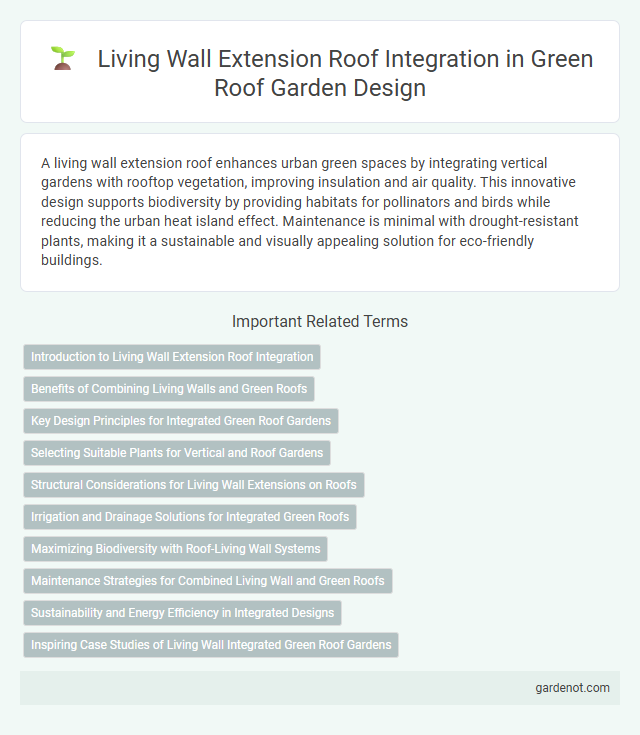A living wall extension roof enhances urban green spaces by integrating vertical gardens with rooftop vegetation, improving insulation and air quality. This innovative design supports biodiversity by providing habitats for pollinators and birds while reducing the urban heat island effect. Maintenance is minimal with drought-resistant plants, making it a sustainable and visually appealing solution for eco-friendly buildings.
Introduction to Living Wall Extension Roof Integration
Living wall extension roof integration enhances urban green infrastructure by combining vertical gardens with green roofing systems to maximize biodiversity and improve air quality. This approach supports thermal regulation and stormwater management by expanding vegetated surfaces on building exteriors. Incorporating living walls on roof extensions optimizes space use while providing aesthetic and environmental benefits in dense urban areas.
Benefits of Combining Living Walls and Green Roofs
Combining living walls with green roofs enhances urban biodiversity by supporting diverse plant species and creating multi-dimensional habitats. This integration improves insulation and energy efficiency, reducing heating and cooling costs in buildings. Additionally, the combined system enhances air quality by filtering pollutants and capturing airborne particulates more effectively than standalone installations.
Key Design Principles for Integrated Green Roof Gardens
Key design principles for integrated living wall extension roofs include selecting drought-tolerant plant species to ensure sustainability and reduce maintenance. Efficient irrigation systems tailored to vertical and horizontal planting zones optimize water usage and promote plant health. Structural load capacity and waterproofing are critical factors to prevent damage and ensure long-term durability of the green roof garden.
Selecting Suitable Plants for Vertical and Roof Gardens
Selecting suitable plants for living wall extension roofs is crucial for creating sustainable green roofs that thrive under variable environmental conditions. Drought-tolerant succulents, native grasses, and hardy perennials such as Sedum, Echeveria, and Festuca optimize water retention and withstand wind exposure on vertical and rooftop surfaces. Incorporating species with shallow root systems and high resistance to temperature fluctuations ensures long-term vitality and structural stability of green roof ecosystems.
Structural Considerations for Living Wall Extensions on Roofs
Living wall extensions on roofs require careful structural assessment to support the additional weight of soil, plants, and irrigation systems, often necessitating reinforced roofing membranes and load-bearing elements. Integrating moisture barriers and root-resistant layers protects the roof structure from water damage and root intrusion. Engineering consultations ensure compliance with building codes and optimize the distribution of dynamic and static loads for long-term durability.
Irrigation and Drainage Solutions for Integrated Green Roofs
Living wall extension roofs require advanced irrigation systems that deliver consistent moisture to vertical and rooftop vegetation, ensuring optimal plant health and growth. Efficient drainage solutions prevent waterlogging by directing excess water away, reducing structural load and promoting root aeration. Integrating smart irrigation controllers with moisture sensors tailors water delivery to plant needs, enhancing sustainability in green roof designs.
Maximizing Biodiversity with Roof-Living Wall Systems
Living wall extension roofs integrate vertical green spaces with rooftop gardens, significantly enhancing urban biodiversity by providing diverse habitats for pollinators, birds, and beneficial insects. These roof-living wall systems use a variety of native plants that support local ecosystems and improve air quality through natural filtration processes. Incorporating modular, drought-resistant vegetation maximizes sustainability and resilience while promoting ecological connectivity in densely built environments.
Maintenance Strategies for Combined Living Wall and Green Roofs
Maintenance strategies for combined living walls and green roofs emphasize regular irrigation, nutrient monitoring, and pest control to ensure plant health and system longevity. Integrated sensors can optimize water use by detecting moisture levels in both vertical and horizontal growth zones. Seasonal inspections and pruning prevent structural damage and promote balanced growth across the combined green infrastructure.
Sustainability and Energy Efficiency in Integrated Designs
Living wall extension roofs enhance sustainability by improving building insulation, reducing urban heat islands, and promoting biodiversity. Integrating vegetation on vertical surfaces alongside green roofs optimizes energy efficiency through natural cooling and air filtration, lowering HVAC demands. This combined approach supports carbon sequestration and stormwater management, advancing eco-friendly architectural solutions.
Inspiring Case Studies of Living Wall Integrated Green Roof Gardens
Living wall integrated green roof gardens demonstrate innovative urban greening solutions that maximize biodiversity and improve air quality. Case studies reveal significant reductions in building energy use and enhanced aesthetic appeal, showcasing the dual benefits of vertical greenery and rooftop vegetation. Implementations in cities like Toronto and Singapore highlight how living walls combined with green roofs create microhabitats, support pollinators, and mitigate urban heat island effects effectively.
Living wall extension roof Infographic

 gardenot.com
gardenot.com